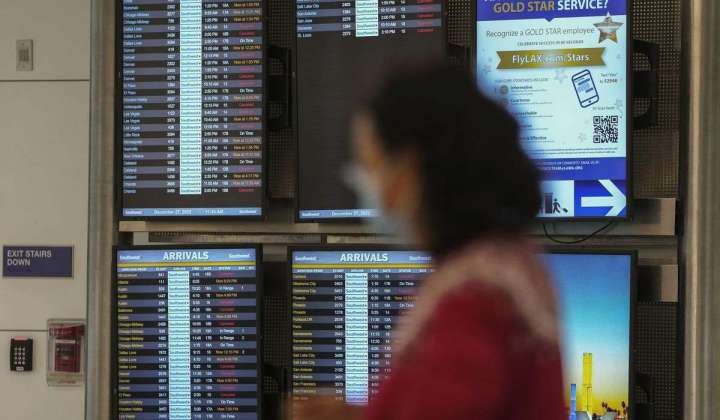Problems cascading for Southwest Airlines as cancellations pile up and authorities take notice

Southwest Airlines canceled more than 2,500 flights Wednesday and another 2,300 for Thursday, stranding tens of thousands of passengers as it grapples with a systemwide meltdown.
The chaos started with the winter storms that buffeted the nation over the Christmas holiday weekend. Whereas other airlines have recovered, Southwest has spiraled. The carrier has already nixed 2,348 more flights for Thursday, 58% of its planned total, according to flight tracking website FlightAware.
Wednesday’s cancellations make up 62% of its scheduled flights.
“As we continue the work to recover our operation, we have made the decision to continue operating a reduced schedule by flying roughly one-third of our schedule for the next several days,” Southwest said Tuesday.
The debacle prompted outrage from the Transportation Department, which oversees the Federal Aviation Administration.
“It’s a shocking and unacceptable level of disruption combined with passengers being unable to get anybody on the phone to help them, and the airline indicating that they’re actually not able to fully keep track of where their own flight crews are,” Transportation Secretary Pete Buttigieg told ABC News Live Prime.
Southwest‘s labor unions blamed the airline’s flight-scheduling technology and lack of workers for the chaos.
“The phone system the company uses is just not working. They’re just not manned with enough manpower in order to give the scheduling changes to flight attendants, and that’s created a ripple effect that is creating chaos throughout the nation,” Lyn Montgomery, president of TWU Local 556, which represents Southwest flight attendants, told CNN.
Southwest Airlines Pilots Association President Casey Murray took a more combative tone in a statement to air travel website Simple Flying: “Southwest Airlines has buried its head in the sand regarding its operational processes and IT. And even though irrefutable analytics and data have been provided by us again and again, pride in their outdated processes and technology continues to drive the management.”
Part of the issue is how Southwest structures its flight schedule each day. Unlike many airlines based around major hubs, Southwest has a point-to-point system, with planes traveling from destination to destination instead of returning to the hub between flights.
“We build our flight schedule around communities, not hubs. So we’re the largest airline in 23 of the top 25 travel markets in the U.S. cities where large numbers of scheduled flights simultaneously froze as record bitter cold brought challenges for all airlines,” Southwest Airlines CEO Bob Jordan explained in a video on the Southwest website.
Whereas other airlines were able to restore full service by supplying staff and planes from their central hubs, Southwest was left with crews, pilots and planes out of position.
The mass cancellations are a way to clear the slate and let crews and planes be put in place for the resumption of normal operations.
“With our large fleet of airplanes and flight crews out of position in dozens of locations and after days of trying to operate as much of our full schedule across the busy holiday weekend, we reached a decision point to significantly reduce our flying to catch up,” Mr. Jordan said.
The company said it would try to mollify customers with several measures. Passengers traveling Jan. 2 can rebook in the same class or travel on standby at no extra charge within 30 days of the original flight. The company also said it would reimburse “reasonable requests” for meals, hotels and alternate transportation between Dec. 24 and Jan. 2.






